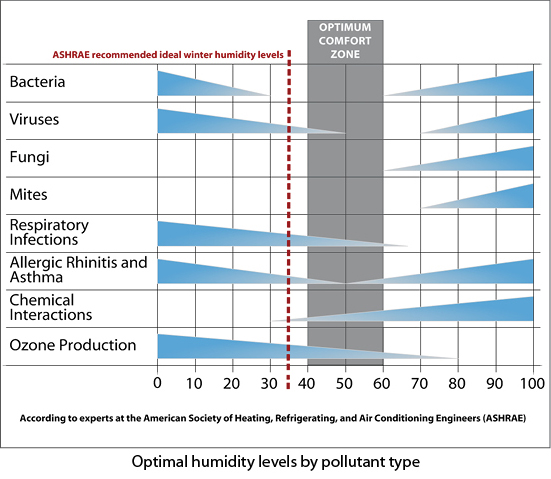WHY VENTILATE?
To bring in oxygen. All living beings consume oxygen. Breathing turns oxygen into carbon dioxide (CO2), which can cause headaches, tiredness and concentration issues. Ventilation removes carbon dioxide from the house while introducing fresh air.
To control humidity. Human activity creates humidity (breathing, baths, showers, cooking, laundry). For example, a family of four can release about 20 litres of water vapour in the air of the home every day. Excess moisture is harmful to several materials and objects because it can cause expansion, loss of adhesion, odours, oxidation (rust), mould, rotting and condensation. Ventilation evacuates this excess water vapour. On the other hand, insufficient moisture dries out our respiratory system and makes us vulnerable to viruses and bacteria. Low humidity levels can also cause wood to crack. As shown in graph the ideal humidity level is between 40% and 60%, or 35% if the outside temperature is close to -20°C (-4°F) or lower.
To eliminate pollutants. Odours, smoke, aerosols, solvent and glue fumes, pollen and mould spores are all pollutants that should be evacuated to reduce the risk of contracting respiratory allergies which can cause rhinitis, asthma, and bronchitis. Ventilation also reduces the risk of exposure to radon gas formed by the degradation of uranium found naturally in the soil, considered the second leading cause of lung cancer after tobacco smoke. Good ventilation creates a healthy and nurturing environment for you and your loved ones.
Natural ventilation or MINOTAIR ventilation?
In the past, we relied on air leakage to ventilate homes. Today, improved construction methods have increased the airtightness of houses with the installation of continuous vapour barriers and air barriers, as well as better sealed windows. Air leakage is no longer an adequate method to fulfill the ventilation needs of modern houses.The National Building Code (NBC) recognizes two types of ventilation: natural and mechanical whose characteristics are described in the following table.
| Natural ventilation | Mechanical ventilation with MINOTAIR |
| Subject to weather conditions | Provides a constant supply of oxygen |
| Depends on the actions of the occupants | Runs at all times |
| Depends on the layout of the house | Ventilate all the key rooms |
| Produces discomfort in winter and summer | Contributes to the comfort of the occupants |
| Causes significant additional heating and cooling costs in summer and winter | Recovers a portion of the energy to avoid additional heating and cooling costs |
| Lets in dust and particles | Filters the air constantly |




